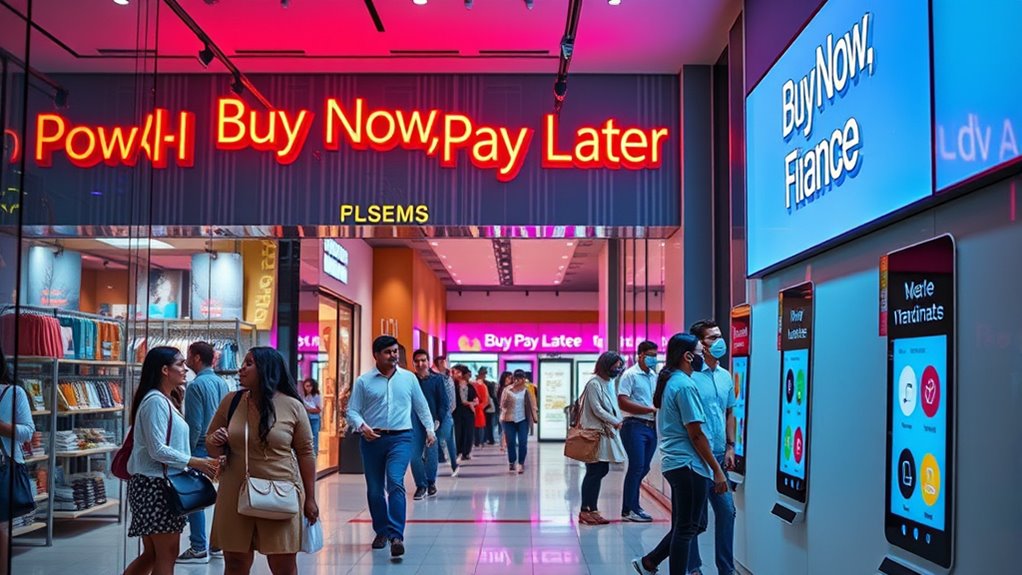The BNPL industry is booming, driven by your desire for flexible, convenient payments that encourage spontaneous spending and access to high-ticket items. However, regulators are watching closely to prevent consumer debt problems, which could lead to stricter rules and higher costs for providers. While growth looks promising through 2025, responsible lending and evolving regulations will shape its future. Keep exploring to understand whether BNPL’s expansion can sustain itself long-term.
Key Takeaways
- BNPL’s rapid growth boosts consumer spending but raises concerns over potential debt accumulation and financial vulnerability.
- Industry adoption remains strong through 2025, driven by convenience, retail integration, and AI-driven personalization.
- Regulatory scrutiny is increasing, with potential rules to enhance transparency and limit consumer debt risks.
- Future success depends on balancing industry expansion with responsible lending and adapting to stricter regulatory environments.
- Technological advances and consumer-focused transparency suggest BNPL will continue expanding responsibly through 2025.

Buy Now, Pay Later (BNPL) has rapidly transformed the way consumers shop by offering flexible payment options that make purchases more accessible. Instead of paying upfront, you can split your payments into smaller, manageable installments, which appeals to a broad range of consumers seeking convenience and affordability. This shift has considerably influenced consumer behavior, encouraging more spontaneous spending and enabling you to buy high-ticket items without immediate financial strain. As BNPL options become integrated into various retail platforms, you might find yourself more inclined to make impulse purchases or opt for bigger-ticket items, knowing you can spread out the cost over time. This convenience has led to increased adoption across demographics, particularly among younger consumers who are comfortable with digital financial tools. However, this rapid growth isn’t without challenges. Regulatory authorities are increasingly scrutinizing BNPL providers due to concerns about consumer debt and transparency. They worry that without clear rules, consumers may underestimate the long-term costs or overextend their finances, leading to potential financial distress. For you, this means that future regulations could impose stricter borrowing limits, clearer disclosures, or mandatory affordability checks before approving BNPL plans. Such measures aim to protect consumers from falling into debt traps while ensuring that companies operate transparently. As the industry evolves, you may notice more oversight, which could influence how flexible or accessible BNPL services remain. Additionally, regulatory challenges could lead to higher costs for providers, potentially impacting the availability or pricing of BNPL options. Despite these hurdles, the appeal of BNPL continues to grow, especially as merchants and financial institutions seek to enhance customer experience and boost sales. For you, this means that BNPL might become more integrated into your shopping routines, with more platforms offering these options at checkout. Still, it’s essential to stay informed about potential changes in regulations, as they could alter the terms and conditions you’re accustomed to. Overall, the BNPL trend appears poised for continued expansion, but its success will depend on how well providers and regulators balance growth with consumer protection. As a shopper, understanding the regulatory landscape and your own financial limits will be key to making the most of BNPL options without falling into debt. The future of BNPL hinges on responsible lending practices and effective regulation—factors that could either sustain its boom or lead to a cautious slowdown by 2025. Additionally, the integration of AI-driven insights is expected to further personalize and optimize BNPL offerings, making them more tailored to individual financial situations and risk profiles.
Frequently Asked Questions
How Does BNPL Impact Consumer Debt Levels Long-Term?
You might find that BNPL increases your long-term consumer debt, especially if you underestimate the credit risk involved. While it offers convenience, it can lead to overspending and missed payments, harming your credit score. Improving your financial literacy helps you manage BNPL responsibly, preventing debt from spiraling. If you’re cautious and aware of your repayment capabilities, BNPL can be a helpful tool rather than a long-term burden.
What Regulatory Changes Are Anticipated for BNPL Providers Worldwide?
Imagine a BNPL provider in Europe adapting to new regulations requiring stricter consumer protection. You’ll likely see increased regulatory compliance measures worldwide, such as clearer disclosures and affordability checks. Governments aim to prevent over-indebtedness, so expect tighter rules in jurisdictions like the U.S., UK, and Australia. As a result, BNPL providers must prioritize consumer protection, ensuring transparent terms and responsible lending to stay compliant and maintain consumer trust.
How Do BNPL Options Vary Across Different Countries and Regions?
You’ll notice that BNPL options vary across countries and regions due to regional differences and cultural influences. In some areas, consumers prefer short-term, interest-free plans, while others embrace longer-term financing. Cultural attitudes toward debt also shape adoption; for instance, in cultures with cautious views on borrowing, BNPL usage is lower. These regional nuances influence how providers tailor their offerings to meet local preferences and regulatory landscapes.
What Are the Most Common Consumer Demographics Using BNPL Services?
You’ll find that younger consumers, especially Millennials and Gen Z, dominate BNPL usage due to their preference for flexible payment options. Demographic trends show these groups value convenience and transparency, making BNPL appealing. Many use it for discretionary spending, online shopping, or managing cash flow. Your understanding of consumer preferences reveals that affordability and ease of use drive BNPL adoption, especially among tech-savvy, budget-conscious demographics seeking quick, interest-free payments.
How Do Merchants Benefit From Offering BNPL Payment Options?
You benefit from offering BNPL options by gaining increased merchant flexibility and providing payment convenience to your customers. This encourages higher sales, reduces cart abandonment, and attracts a broader demographic. With flexible payment plans, your customers enjoy easier purchasing experiences, leading to improved customer satisfaction and loyalty. Ultimately, integrating BNPL boosts your revenue and competitive edge, making your business more appealing in today’s fast-paced, convenience-driven market.
Conclusion
As you consider the Buy Now, Pay Later trend, it’s clear that while it offers convenience—like a shopper splitting a $200 purchase into four payments—it also carries risks if not managed carefully. For instance, imagine a young adult overspending with multiple BNPL plans and struggling to keep up, leading to financial stress. Staying informed and using these services responsibly can help you enjoy their benefits without falling into debt. The future depends on balancing innovation with consumer protection.









